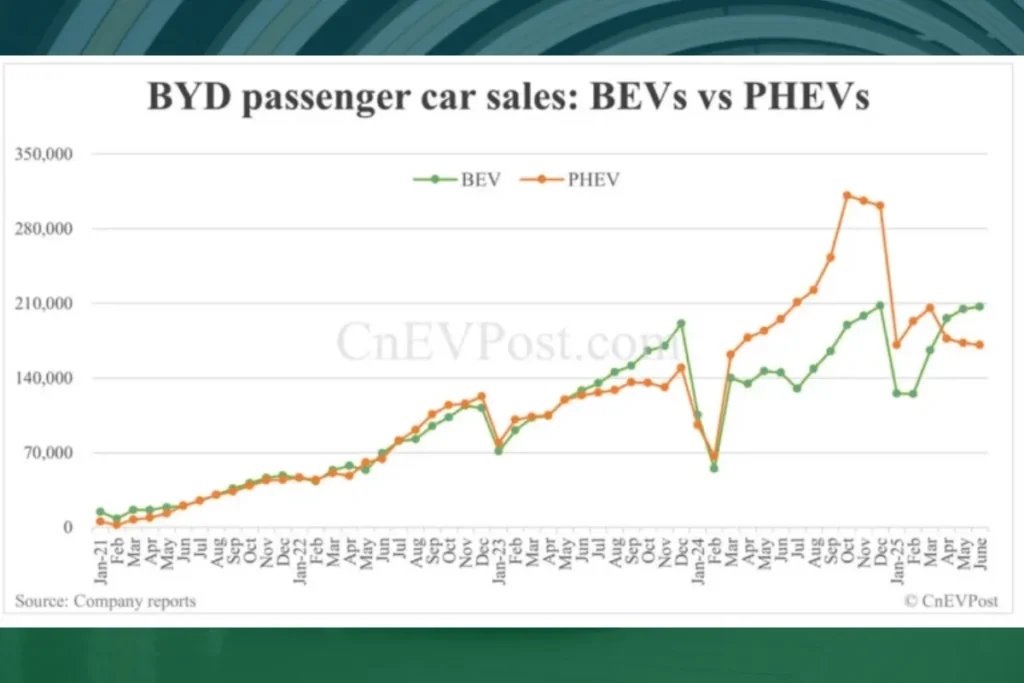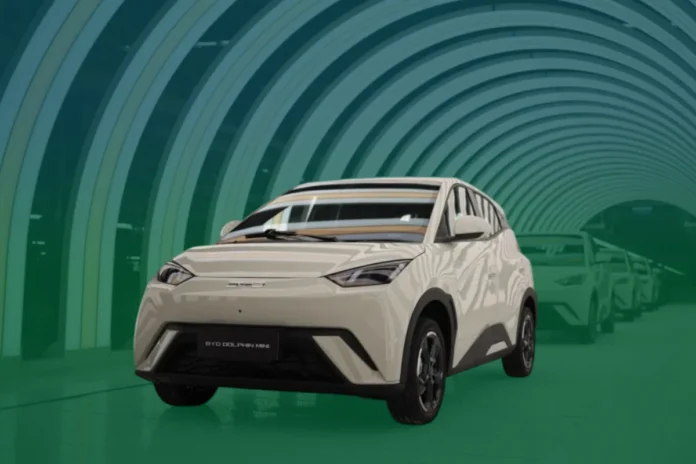The electric vehicle (EV) industry is witnessing a seismic shift as BYD overtakes Tesla to claim the title of the world’s leading EV manufacturer. In a remarkable turn of events, the Chinese automaker has surged ahead, leaving Tesla trailing in its wake. This article explores how BYD has redefined the EV landscape with its innovative technology, strategic market approach, and relentless focus on growth, positioning itself as the new titan of electric mobility.
Table of Contents
A Historic Milestone for BYD
In the first half of 2025, BYD achieved a monumental feat by delivering an impressive 1,023,381 electric vehicles, outpacing Tesla’s 720,809 units by a significant margin of over 300,000 vehicles. This gap underscores BYD’s explosive growth and its ability to capture market share in a fiercely competitive industry. The Chinese giant’s record-breaking performance in Q1 2025, with over 626,000 EVs sold, further cements its dominance. These figures reflect not only BYD’s manufacturing prowess but also its ability to meet soaring global demand for affordable, high-quality electric cars.
While Tesla has long been synonymous with electric vehicles, its recent struggles have opened the door for BYD’s ascent. Tesla reported a sharp 13.5% decline in deliveries, totaling 384,122 units in the same period, marking its worst performance in years. This downturn, coupled with delays in launching new models like the much-anticipated affordable EV, has weakened Tesla’s grip on the market. Meanwhile, BYD’s strategic focus on scalability, technological innovation, and market adaptability has propelled it to the forefront.
BYD’s Winning Formula: Technology and Accessibility
What sets BYD apart in the crowded EV market? The answer lies in its multifaceted approach, blending cutting-edge technology with a keen understanding of consumer needs. Unlike Tesla, which focuses on premium models, BYD offers a diverse range of vehicles that cater to various market segments, from budget-conscious buyers to luxury enthusiasts. Models like the BYD-Seal U, Dolphin Surf, and Sea Lion 07 have gained traction for their competitive pricing and advanced features, making electric mobility accessible to a broader audience.
BYD’s technological edge is particularly evident in its battery innovations. The company’s proprietary Blade Battery, based on lithium-iron-phosphate (LFP) chemistry, offers enhanced safety, longevity, and affordability compared to traditional nickel-manganese-cobalt (NMC) batteries used by competitors like Tesla. Additionally, BYD’s 1,000-volt platform enables ultra-fast charging, with models like the BYD-Han L and Tang L capable of gaining 400 km of range in under 10 minutes—outpacing Tesla’s fastest charging times.
The company’s vertical integration is another key strength. BYD not only manufactures vehicles but also produces its own batteries, supplying major automakers like BMW, Mercedes, and even Tesla itself. This control over the supply chain allows BYD to maintain competitive pricing while ensuring consistent quality. In 2024, BYD invested over £2.5 billion in research and development, employing more than 110,000 engineers and filing an average of 32 patents daily, reinforcing its position as an innovation powerhouse.

Tesla’s Struggles: A Perfect Storm
Tesla’s decline in 2025 has been driven by a combination of internal and external factors. The company’s European sales plummeted by 49% in April 2025, with only 7,261 vehicles sold, despite a 28% growth in the broader EV market. This stark contrast highlights Tesla’s challenges, including an aging model lineup and controversial leadership decisions. The restyled Tesla Model Y, expected to reinvigorate sales, has failed to meet expectations, with high prices deterring budget-conscious buyers.
Moreover, Tesla’s reliance on a limited range of premium models has left it vulnerable to competitors like BYD, which offer more affordable options. The absence of a budget-friendly Tesla model, originally slated for release in early 2025, has further eroded its market share. Public perception of Tesla’s CEO has also played a role, with polarizing decisions impacting the brand’s image and consumer confidence.
| Metric | BYD | Tesla |
|---|---|---|
| Q1 2025 EV Deliveries | 626,000+ | 384,122 |
| H1 2025 EV Deliveries | 1,023,381 | 720,809 |
| Sales Growth (2024-2025) | +25% | -13.5% |
| Charging Speed | 400 km in <10 min (1,000V) | ~200 km in 20 min (400V) |
| Battery Chemistry | LFP (Blade Battery) | NMC (4680 Cells) |
| Key Markets | China, Europe, Latin America | North America, Europe, China |
BYD’s European Ambitions
While BYD dominates its home market in China, where it accounts for a significant portion of the 11 million EVs sold globally in 2024, its international expansion is equally ambitious. In Europe, BYD’s sales surged by 196% between April 2024 and April 2025, with 7,231 vehicles registered in April alone, narrowly surpassing Tesla’s 7,165 units. This milestone marks the first time BYD has overtaken Tesla in Europe, a region long considered Tesla’s stronghold.
To fuel this growth, B-Y-D is investing heavily in European infrastructure. The company has opened a factory in Hungary and plans another in Turkey, aiming to produce 150,000 vehicles annually by 2026. These facilities will help BYD avoid hefty EU import tariffs, which currently stand at 17% for B-Y-D compared to higher rates for other Chinese manufacturers. By localizing production, BYD can offer competitive pricing, such as the Dolphin Surf at under £16,000, undercutting many European rivals.
BYD’s European strategy also includes expanding its dealership network, with plans for 100 showrooms in France alone within three years. The company’s partnership with high-profile events, such as the UEFA Euro 2024, has boosted brand visibility, while its recruitment of talent from competitors like Stellantis underscores its commitment to building a strong European presence.
Innovation Beyond Vehicles
BYD’s vision extends beyond traditional car manufacturing. The company is integrating advanced technologies to enhance the driving experience, taking inspiration from Tesla’s tech-forward approach. For instance, BYD’s God’s Eye autonomous driving system, available in variants from affordable to luxury models, combines LiDAR, cameras, and radar for precision parking and semi-autonomous capabilities. The high-end version, reserved for BYD’s luxury Yangwang brand, boasts 600 TOPS of computing power, rivaling Tesla’s Full Self-Driving (FSD) technology.
Additionally, BYD is introducing lifestyle features to appeal to modern consumers. Models like the BYDSong DM-i will include built-in refrigerators capable of cooling to -6°C, a feature previously reserved for luxury vehicles. Partnerships with tech giants like NVIDIA enable cloud-based gaming via GeForce NOW, transforming BYD vehicles into mobile entertainment hubs. These innovations reflect BYD’s ambition to redefine vehicles as “smartphones on wheels.”
The Road Ahead: Can Tesla Recover?
Despite its current challenges, Tesla remains a formidable player in the EV industry. With a global delivery total of 1.79 million vehicles in 2024, Tesla narrowly maintained its lead over BYD’s 1.76 million units for the year. However, BYD’s momentum suggests it could claim the top spot annually as early as 2025. Tesla’s plans for a budget-friendly model and the expansion of its Full Self-Driving technology in Europe could help it regain ground, but the company must act swiftly to counter BYD’s aggressive pricing and innovation.
Analysts predict that BYD’s focus on affordability and rapid technological advancements will continue to challenge Tesla’s dominance. According to Liz Lee of Counterpoint, BYD’s advancements in fast-charging technology could be a “game-changer” for the global EV market, particularly in China, where infrastructure supports ultra-fast charging. Meanwhile, Tesla’s reliance on slower 400-volt architecture puts it at a disadvantage in this critical area.
Why BYD’s Rise Matters
BYD’s ascent signals a new era in the EV industry, one where affordability, scalability, and innovation take center stage. The company’s ability to produce high-quality vehicles at lower price points challenges the premium-focused strategies of Western automakers. For UK consumers, BYD’s growing presence offers exciting opportunities to access cutting-edge EVs at competitive prices, potentially accelerating the transition to sustainable mobility.
However, BYD’s rise also raises questions about the future of the European auto industry. With Chinese manufacturers benefiting from government subsidies and lower production costs, European regulators have imposed tariffs to protect local brands like Volkswagen and Stellantis. Yet, BYD’s strategic investments in European factories and its focus on localized production could mitigate these barriers, positioning it as a long-term leader in the region.
Conclusion: A New Leader in Electric Mobility
As BYD overtakes Tesla, it marks the end of an era dominated by the American automaker and the beginning of a new chapter led by Chinese innovation. BYD’s blend of advanced technology, affordable pricing, and aggressive expansion has reshaped the EV landscape, offering consumers worldwide more choices than ever. For UK drivers, BYD’s arrival promises affordable, feature-rich EVs that could redefine expectations for electric mobility.
While Tesla’s influence remains undeniable, its ability to reclaim the top spot will depend on its capacity to innovate and adapt. For now, BYD stands tall as the new giant of the electric vehicle industry, proving that the future of mobility is not only electric but also fiercely competitive.




